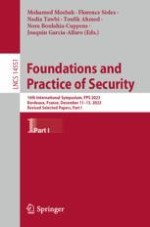2024 | OriginalPaper | Buchkapitel
IntelliTweet: A Multifaceted Feature Approach to Detect Malicious Tweets
verfasst von : Eric Edem Dzeha, Guy-Vincent Jourdan
Erschienen in: Foundations and Practice of Security
Verlag: Springer Nature Switzerland
Aktivieren Sie unsere intelligente Suche, um passende Fachinhalte oder Patente zu finden.
Wählen Sie Textabschnitte aus um mit Künstlicher Intelligenz passenden Patente zu finden. powered by
Markieren Sie Textabschnitte, um KI-gestützt weitere passende Inhalte zu finden. powered by
